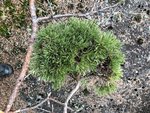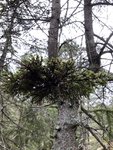I agree with
@Wires_Guy_wires
You are very, very unlikely to have success with air layering either of these witches brooms. AND if you try to air layer these 2 brooms, the end result will be the eventual death of the brooms.
Best would be to collect scions, wrap the scions with damp long fiber sphagnum moss, wrap in plastic, and store the scions in your refrigerator. You can safely store the scions for several weeks this way, since it is still winter in Sweden. Obtain seedling Pinus sylvestris and Picea abies to use as understock. The seedlings should have trunks larger diameter than the scion cuttings you took. Once you have the seedlings collected, you can graft the witches brooms low on the trunks of the understock. Best is if you could graft into the root zone of the understock, this is a little tricky if you have never done grafting, try to graft within one inch of the soil line on the understock, that will give you a tree that may be useful for bonsai in time. This is the only "proven method" to bring witches brooms into cultivation.
If you have never done any grafting, seek out a local bonsai practitioner or a fruit tree grower who has done it before to have them show you how in person. I took a 4 hour class to learn grafting, and there is much you need to see in person, such as how to hold your knife, how to prepare the scion, and so forth, that just do not translate to the written word. In the USA we have a group called the "Fruit Explorers" that is dedicated to preserving heirloom cultivars of apples and other culinary fruit trees, These people are all hobbyists, and very dedicated to preservation of fruit varieties, which is usually done by grafting. If Sweden has a similar group likely there will be someone willing to demonstrate grafting for you at no charge. Your local agriculture university will have people who are expert at grafting also, they may or may not charge for the help.



 so
so




 so
so

